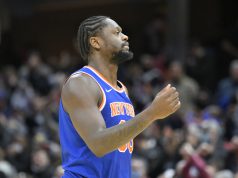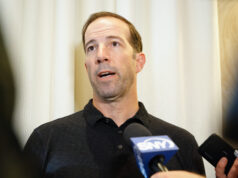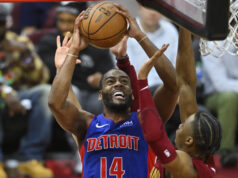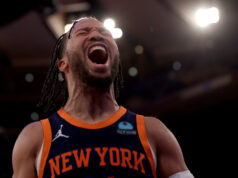Rookie RJ Barrett has looked promising on a shoddy New York Knicks team during his inaugural campaign in the pros.
New York Knicks shooting guard RJ Barrett was fantastic in his only season at Duke last year, and fans were eager to see if he would live up to the hype upon his draft selection. Seeing as the rookie was the Knicks’ first top-three pick since Patrick Ewing was taken No. 1 overall in 1985, the hype and excitement were very real.
Barrett hasn’t been perfect, but he’s looked solid nonetheless. In 56 games this season, the 19-year-old is averaging 14.3 points per game, five rebounds (the vast majority of which have been on the defensive end), and 2.6 assists. He’s shooting 40.2% from the field, 32% from three, and 61.4% from the free-throw line.
He’s sixth in rebounds and third in steals (one per game) among rookies playing at least 20 minutes a game. Barrett is also third among rookies who’ve played at least 40 matchups in points per game after Kendrick Nunn (Miami Heat) and Ja Morant (Memphis Grizzlies).
But anyone even remotely familiar with Barrett will say that his most significant flaw has been his shooting. He’s shooting below league-average in all categories: from the field, from three, and most notably, from the free-throw line. His effective field goal percentage and true shooting percentage are in the bottom five when it comes to the 17 rookies with at least 40 games played and an average of 20 minutes per night.
Additionally, Barrett shoots left-handed and that’s been an immense advantage for him. Defenders are already beginning to catch on though. For that reason, he needs to work on improving play with his right hand. That’s been a slight weakness for him thus far, so if he can develop in that department, he’ll advance by leaps and bounds.
He’s shown potential on defense but can definitely improve that part of his game as well. It’s problematic that the team defends better when he’s not on the court.
Lastly, although not as major as his shooting, Barrett’s passing game hasn’t been an intriguing aspect. He sometimes holds onto the ball for too long and doesn’t give it up when he should.
That may seem a little harsh, but Barrett’s strengths are still greater than his weaknesses. The most impressive part of Barrett’s game and what makes him so dominant is his ability to drive to the rim and even just get to the paint. Only Morant and Brandon Clarke of Memphis have averaged more points in the paint among rookie guards.
Barrett is so good at getting to the rim that defenders don’t know how to stop him, so they just foul him. This could very well end up defining the type of player he is for the entirety of his career, and that’s why he must work on his free-throw shooting.
It’s great that he can get to the basket but that’s futile if those efforts won’t generate any points. He must take advantage of something that’s already a huge strength and develop it even further.
Barrett also appears to be great in transition: only Morant and Coby White of the Chicago Bulls have averaged more points off turnovers among rookie guards.
Something else that makes Barrett look even more promising is the fact that he just keeps improving. In the first 28 games of the season, he was shooting an abysmal .389/.285/.543 while averaging 15.6 points per 36 minutes. In the next 28 games, he shot an improved .415/.343/.688 while averaging 18.4 points per 36 minutes.
Since the All-Star Break, he’s averaged 17.2 points and 20.5 points per 36 minutes. These statistics should be convincing enough that the youngster is definitely on the right track. Numbers don’t lie and he’s proven that he’s fully capable of progressing when given the chance.
Barrett has also displayed great chemistry with Knicks center Mitchell Robinson. The ease and flow with which the two play is noticeable. Viewers can’t help but picture them on the team’s starting five for years to come.
The last praise-worthy characteristics Barrett possesses are intangible but important. RJ is 19 years old but never looks nervous or overwhelmed on the court. He plays with ferocity, a key trait for any player to carry. It’s especially vital for those who regularly play at Madison Square Garden.
New York is the toughest place to play in any sport but Barrett makes it look easy. If he does end up spending at least a good chunk of his career here, playing in this market likely won’t be an issue for him.
Finally, the fact that Barrett is playing as well as he has on a team deprived of talent is more than impressive. His supporting cast is underwhelming, and he doesn’t really have anyone on the team who can mentor him. Needless to say, he’s already better than most of his teammates.
This may be an explanatory factor of one of his weaknesses: his passing. He may be less inclined to pass the ball because scoring isn’t guaranteed with the majority of his teammates.
All in all, Barrett looks good. The season isn’t technically over yet and he already looks like he’ll be part of the team’s core. Both Barrett and the Knicks have work to do, though.
Barrett needs to focus his attention on shooting in order to live up to his superstar potential. Nonetheless, the Knicks must acquire some talent for him during the offseason. Fans can’t expect him to carry the team on his back, especially at his young age.
The Knicks can actually begin a successful rebuild if they prioritize getting Barrett some help. This is especially the case if they want him to stick around and become the face of the franchise.













